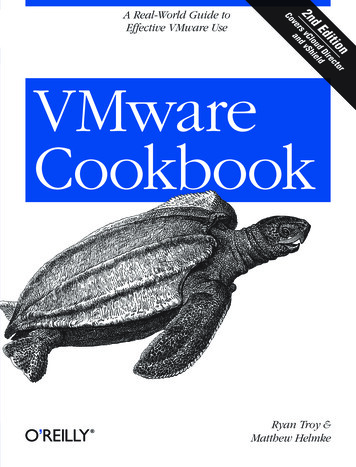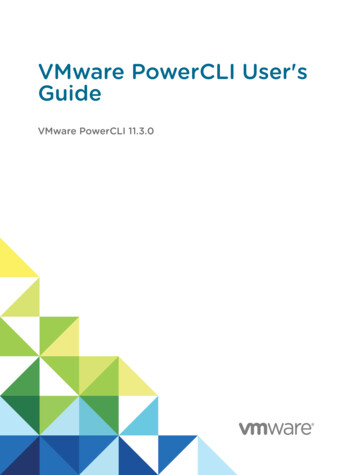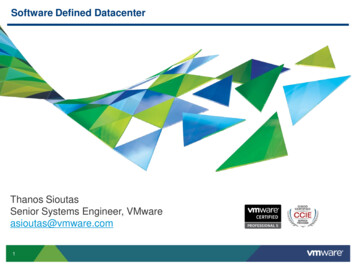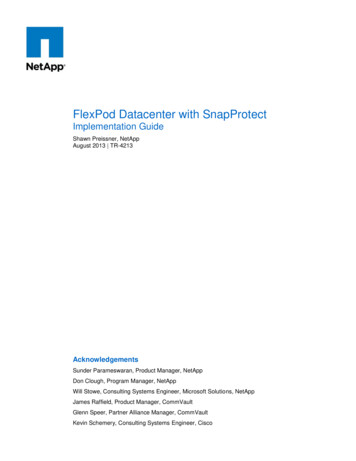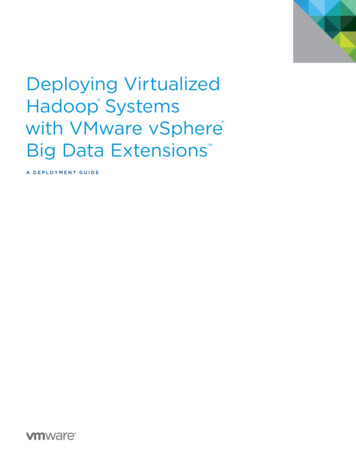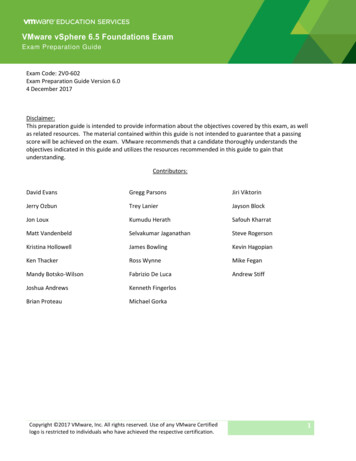
Transcription
FlexPod Datacenter with VMware vSphere7.0 Design GuidePublished: August 2020In partnership with:
About the Cisco Validated Design ProgramThe Cisco Validated Design (CVD) program consists of systems and solutions designed, tested, and documentedto facilitate faster, more reliable, and more predictable customer deployments. For more information, go to:http://www.cisco.com/go/designzone.ALL DESIGNS, SPECIFICATIONS, STATEMENTS, INFORMATION, AND RECOMMENDATIONS (COLLECTIVELY,"DESIGNS") IN THIS MANUAL ARE PRESENTED "AS IS," WITH ALL FAULTS. CISCO AND ITS SUPPLIERSDISCLAIM ALL WARRANTIES, INCLUDING, WITHOUT LIMITATION, THE WARRANTY OF MERCHANTABILITY,FITNESS FOR A PARTICULAR PURPOSE AND NONINFRINGEMENT OR ARISING FROM A COURSE OF DEALING,USAGE, OR TRADE PRACTICE. IN NO EVENT SHALL CISCO OR ITS SUPPLIERS BE LIABLE FOR ANY INDIRECT,SPECIAL, CONSEQUENTIAL, OR INCIDENTAL DAMAGES, INCLUDING, WITHOUT LIMITATION, LOST PROFITS ORLOSS OR DAMAGE TO DATA ARISING OUT OF THE USE OR INABILITY TO USE THE DESIGNS, EVEN IF CISCOOR ITS SUPPLIERS HAVE BEEN ADVISED OF THE POSSIBILITY OF SUCH DAMAGES.THE DESIGNS ARE SUBJECT TO CHANGE WITHOUT NOTICE. USERS ARE SOLELY RESPONSIBLE FOR THEIRAPPLICATION OF THE DESIGNS. THE DESIGNS DO NOT CONSTITUTE THE TECHNICAL OR OTHERPROFESSIONAL ADVICE OF CISCO, ITS SUPPLIERS OR PARTNERS. USERS SHOULD CONSULT THEIR OWNTECHNICAL ADVISORS BEFORE IMPLEMENTING THE DESIGNS. RESULTS MAY VARY DEPENDING ONFACTORS NOT TESTED BY CISCO.CCDE, CCENT, Cisco Eos, Cisco Lumin, Cisco Nexus, Cisco StadiumVision, Cisco TelePresence, Cisco WebEx,the Cisco logo, DCE, and Welcome to the Human Network are trademarks; Changing the Way We Work, Live,Play, and Learn and Cisco Store are service marks; and Access Registrar, Aironet, AsyncOS, Bringing the MeetingTo You, Catalyst, CCDA, CCDP, CCIE, CCIP, CCNA, CCNP, CCSP, CCVP, Cisco, the Cisco Certified InternetworkExpert logo, Cisco IOS, Cisco Press, Cisco Systems, Cisco Systems Capital, the Cisco Systems logo, CiscoUnified Computing System (Cisco UCS), Cisco UCS B-Series Blade Servers, Cisco UCS C-Series Rack Servers,Cisco UCS S-Series Storage Servers, Cisco UCS Manager, Cisco UCS Management Software, Cisco UnifiedFabric, Cisco Application Centric Infrastructure, Cisco Nexus 9000 Series, Cisco Nexus 7000 Series. Cisco PrimeData Center Network Manager, Cisco NX-OS Software, Cisco MDS Series, Cisco Unity, Collaboration WithoutLimitation, EtherFast, EtherSwitch, Event Center, Fast Step, Follow Me Browsing, FormShare, GigaDrive,HomeLink, Internet Quotient, IOS, iPhone, iQuick Study, LightStream, Linksys, MediaTone, MeetingPlace,MeetingPlace Chime Sound, MGX, Networkers, Networking Academy, Network Registrar, PCNow, PIX,PowerPanels, ProConnect, ScriptShare, SenderBase, SMARTnet, Spectrum Expert, StackWise, The Fastest Wayto Increase Your Internet Quotient, TransPath, WebEx, and the WebEx logo are registered trademarks of CiscoSystems, Inc. and/or its affiliates in the United States and certain other countries.All other trademarks mentioned in this document or website are the property of their respective owners. The useof the word partner does not imply a partnership relationship between Cisco and any other company. (0809R) 2020 Cisco Systems, Inc. All rights reserved.2
Table of ContentsExecutive Summary . 5Program Summary . 6Solution Overview . 7Introduction . 7Audience . 7What’s New in this Release? . 7Technology Overview . 9FlexPod System Overview . 9Cisco Unified Computing System . 10Cisco UCS C125 M5 Rack Servers in the Cisco UCS C4200 Series Rack Server Chassis . 10Cisco UCS B200 M5 Blade Servers . 11Cisco UCS C220 M5 Rack Servers . 11Intel Optane DC Persistent Memory in Cisco UCS B200 M5 and Cisco UCS C220 M5 Servers . 12Cisco UCS 6400 Series Fabric Interconnects . 12Cisco UCS 2408 Fabric Extender . 13Cisco UCS 1400 Series Virtual Interface Cards (VICs) . 13Cisco UCS Differentiators . 14NetApp AFF A-Series Storage . 15NetApp AFF A800 Storage . 15NetApp AFF A400 Storage . 16NetApp ONTAP 9.7 .17Virtual Storage Console 9.7.1 . 20NetApp SnapCenter .22Active IQ Unified Manager 9.7P1 . 25Active IQ . 27Cisco MDS. 29MDS Insertion into FlexPod . 29Smart Zoning with MDS . 30Cisco Nexus . 30Virtual Port Channel (vPC). 31Cisco Nexus 9000 Best Practices . 32Cisco Nexus 93180YC-FX SAN Switching . 33Cisco Data Center Network Manager (DCNM)-SAN . 33Cisco Intersight . 34VMware vSphere 7.0.343
Solution Design . 35Physical Topology . 35Considerations . 39Validation. 51Validated Hardware and Software . 51Summary . 53References . 54Products and Solutions .54Interoperability Matrixes .55About the Authors . 56Acknowledgements .564
Executive SummaryExecutive SummaryCisco Validated Designs (CVDs) consist of systems and solutions that are designed, tested, and documented tofacilitate and improve customer deployments. These designs incorporate a wide range of technologies andproducts into a portfolio of solutions that have been developed to address the business needs of our customers.This document describes the Cisco and NetApp FlexPod solution, which is a validated approach for deployingCisco and NetApp technologies as shared cloud infrastructure. This validated design provides a framework fordeploying VMware vSphere, the most popular virtualization platform in enterprise class data centers, on FlexPod.FlexPod is a leading integrated infrastructure supporting a broad range of enterprise workloads and use cases.This solution enables customers to quickly and reliably deploy VMware vSphere based private cloud on integratedinfrastructure.The recommended solution architecture is built on Cisco Unified Computing System (Cisco UCS) using the unifiedsoftware release to support the Cisco UCS hardware platforms including Cisco UCS B-Series blade and C-Seriesrack servers, Cisco UCS 6454 Fabric Interconnects, Cisco Nexus 9000 Series switches, Cisco MDS Fibrechannel switches, and NetApp All Flash series storage arrays. In addition to that, it includes VMware vSphere 7.0,which provides a number of new features for optimizing storage utilization and facilitating private cloud. Error!Reference source not found.Error! Reference source not found.Error! Reference source not found.Error!Reference source not found.
Program SummaryProgram SummaryCisco and NetApp have carefully validated and verified the FlexPod solution architecture and its many use caseswhile creating a portfolio of detailed documentation, information, and references to assist customers intransforming their data centers to this shared infrastructure model. This portfolio includes, but is not limited to thefollowing items: Best practice architectural design Workload sizing and scaling guidance Implementation and deployment instructions Technical specifications (rules for what is a FlexPod configuration) Frequently asked questions and answers (FAQs) Cisco Validated Designs (CVDs) and NetApp Validated Architectures (NVAs) describing a variety of usecasesCisco and NetApp have also built a robust and experienced support team focused on FlexPod solutions, fromcustomer account and technical sales representatives to professional services and technical support engineers.The support alliance between NetApp and Cisco gives customers and channel services partners direct access totechnical experts who collaborate with cross vendors and have access to shared lab resources to resolvepotential issues.FlexPod supports tight integration with virtualized and cloud infrastructures, making it the logical choice for longterm investment. FlexPod also provides a uniform approach to IT architecture, offering a well-characterized anddocumented shared pool of resources for application workloads. FlexPod delivers operational efficiency andconsistency with the versatility to meet a variety of SLAs and IT initiatives, including: Application rollouts or application migrations Business continuity and disaster recovery Desktop virtualization Cloud delivery models (public, private, hybrid) and service models (IaaS, PaaS, SaaS) Asset consolidation and virtualization6
Solution OverviewSolution OverviewIntroductionIndustry trends indicate a vast data center transformation toward shared infrastructure and cloud computing.Business agility requires application agility, so IT teams need to provision applications quickly and resources needto be able to scale up (or down) in minutes.FlexPod Datacenter is a best practice datacenter architecture, designed and validated by Cisco and NetApp tomeet the needs of enterprise customers and service providers. FlexPod Datacenter is built on NetApp All FlashFAS (AFF), Cisco Unified Computing System (Cisco UCS), Cisco MDS, and the Cisco Nexus family of switches.These components combine to enable management synergies across all of a business’s IT infrastructure. FlexPodDatacenter has been proven to be the optimal platform for virtualization and workload consolidation, enablingenterprises to standardize all of their IT infrastructure.AudienceThe audience for this document includes, but is not limited to; sales engineers, field consultants, professionalservices, IT managers, partner engineers, and customers who want to take advantage of an infrastructure built todeliver IT efficiency and enable IT innovation.What’s New in this Release?The primary FlexPod Datacenter with VMware vSphere 7.0 validated design introduced new hardware andsoftware into the portfolio, enabling 10/25/40/100GbE along with native 32Gb FC via the Cisco MDS FibreChannel switch or the Cisco Nexus 93180YC-FX switch. This primary design has been updated to include thelatest Cisco and NetApp hardware and software, along with the following: Support for the Cisco UCS 4.1(2) unified software release, Cisco UCS C125 servers with AMD EPYC 2ndGeneration Processors, Cisco UCS B200-M5 and C220-M5 servers with 2nd Generation Intel XeonScalable Processors, and Cisco 1400 Series Virtual Interface Cards (VICs) Support for the latest Cisco UCS 6454 and 64108 (supported but not validated) Fabric Interconnects Support for the latest Cisco UCS 2408 Fabric Extender Support for the Cisco UCS Port Expander with Cisco UCS VIC 1440, 2408 Fabric Extender, 6400 SeriesFabric Interconnects Support for Intel Optane Persistent Memory in Memory Mode with specific memory configurations and AppDirect Mode Support for 32Gb FC SAN Switching in the Cisco Nexus 93180YC-FX switch Support for Cisco Data Center Network Manager (DCNM)-SAN Version 11.4(1) Support for Cisco Intersight Software as a Service (SaaS) Management Support for the NetApp AFF A400 and AFF A800 (supported but not validated) Storage Controller Support for the latest release of NetApp ONTAP 9.77
Solution Overview Support for NetApp Virtual Storage Console (VSC) 9.7.1 Support for VVOL Datastores/VM over FC, ISCSI and NFS protocol. Support for NetApp SnapCenter and NetApp SnapCenter Plug-in for VMware vSphere Version 4.3.1 Support for NetApp Active IQ Unified Manager 9.7P1 Support for NetApp Active IQ Fibre channel, NFS, iSCSI (appendix) storage design Validation of VMware vSphere 7.0 Unified Extensible Firmware Interface (UEFI) Secure Boot of VMware ESXi 7.0 Trusted Platform Module (TPM) 2.0 Attestation of UEFI Secure Boot of VMware ESXi 7.0 25 or 100 Gigabit per second Ethernet Connectivity 32 Gigabit per second Fibre Channel Connectivity8
Technology OverviewTechnology OverviewFlexPod System OverviewFlexPod is a best practice datacenter architecture that includes the following components: Cisco Unified Computing System Cisco Nexus switches Cisco MDS switches NetApp AFF systemsFigure 1FlexPod Component Families9
Technology OverviewThese components are connected and configured according to the best practices of both Cisco and NetApp toprovide an ideal platform for running a variety of enterprise workloads with confidence. FlexPod can scale up forgreater performance and capacity (adding compute, network, or storage resources individually as needed), or itcan scale out for environments that require multiple consistent deployments (such as rolling out of additionalFlexPod stacks). The reference architecture covered in this document leverages Cisco Nexus 9000 for thenetwork switching element and pulls in the Cisco MDS 9000 for the SAN switching component.One of the key benefits of FlexPod is its ability to maintain consistency during scale. Each of the componentfamilies shown (Cisco UCS, Cisco Nexus, and NetApp AFF) offers platform and resource options to scale theinfrastructure up or down, while supporting the same features and functionality that are required under theconfiguration and connectivity best practices of FlexPod.Cisco Unified Computing SystemCisco UCS C125 M5 Rack Servers in the Cisco UCS C4200 Series Rack Server ChassisThe Cisco UCS C125 M5 server shown in Figure 2, plugs into the Cisco UCS C4200 Rack Server Chassis.Figure 2Cisco UCS C125 M5 Rack Server NodeThe Cisco UCS C4200 chassis extends the capabilities of the Cisco UCS portfolio in a 2-Rack-Unit (2RU) formfactor supporting up to four Cisco UCS C125 M5 Rack Server Nodes. The latest update includes support for AMDEPYC 2 (Rome) 7002 processors validated in this design. The AMD EPYC 2 processors have higher core density(up to 64 cores) and higher performance with an enhanced AMD Zen 2 core design. The AMD EPYC 7001processors will continue to be offered for flexibility of customer choice. Both CPU types deliver significantperformance and efficiency gains in a compact form factor that will improve your application performance whilesaving space. The C4200 and the C125 M5 nodes deliver outstanding levels of capability and performance in ahighly compact package, with: AMD EPYC 7002 (Rome) series processors, with up to 64 cores per socket, AMD EPYC 7001 (Naples)series processors with up to 32 cores per socket. Up to 1 TB of DRAM using sixteen 64-GB DDR4 DIMMs for 2-socket CPU configuration (eightDIMMs/memory channels per CPU) 3200 MHz 16G/32G/64G DIMMs for AMD EPYC 7002 (Rome) CPUs and 2666 MHz 16G/32G/64G DIMMsfor AMD EPYC 7001 (Naples) CPUs Optional dual SD cards or M.2 modular storage for increased storage or boot drive capacity Support for Cisco’s fourth-generation PCIe Virtual Interface Card (VIC) 1455 offering up to 100 Gbps of I/Othroughput with Cisco UCS 6454 FI10
Technology OverviewFor more information about the Cisco UCS C125 M5 Rack Server Nodes in the Cisco UCS C4200 Rack ServerChassis, see: ver-chassis/datasheet-c78-740839.html.Cisco UCS B200 M5 Blade ServersThe Cisco UCS B200 M5 server shown in Figure 3Figure 3, is a half-width blade upgrade from the Cisco UCSB200 M4.Figure 3Cisco UCS B200 M5 Blade ServerIt features: 2nd Gen Intel Xeon Scalable and Intel Xeon Scalable processors with up to 28 cores per socket Up to 24 DDR4 DIMMs for improved performance with up to 12 DIMM slots ready for Intel Optane DCPersistent Memory Up to two GPUs Two Small-Form-Factor (SFF) drive slots Up to two Secure Digital (SD) cards or M.2 SATA drives Up to 80 Gbps of I/O throughput with Cisco UCS 6454 FIFor more information about the Cisco UCS B200 M5 Blade Servers, vers/datasheet-c78-739296.html.Cisco UCS C220 M5 Rack ServersThe Cisco UCS C220 M5 rack server shown in Figure 4, is a high-density 2-socket rack server that is an upgradefrom the Cisco UCS C220 M4.Figure 4Cisco UCS C220 M5 Rack ServerIt features: 2nd Gen Intel Xeon Scalable and Intel Xeon Scalable processors, 2-socket11
Technology Overview Up to 24 DDR4 DIMMs for improved performance with up to 12 DIMM slots ready for Intel Optane DCPersistent Memory Up to 10 Small-Form-Factor (SFF) 2.5-inch drives or 4 Large-Form-Factor (LFF) 3.5-inch drives (77 TBstorage capacity with all NVMe PCIe SSDs) Support for 12-Gbps SAS modular RAID controller in a dedicated slot, leaving the remaining PCIeGeneration 3.0 slots available for other expansion cards Modular LAN-On-Motherboard (mLOM) slot that can be used to install a Cisco UCS Virtual Interface Card(VIC) without consuming a PCIe slot Dual embedded Intel x550 10GBASE-T LAN-On-Motherboard (LOM) ports Up to 100 Gbps of I/O throughput with Cisco UCS 6454 FIFor more information about the Cisco UCS B200 M5 Blade Servers, vers/datasheet-c78-739281.html.Intel Optane DC Persistent Memory in Cisco UCS B200 M5 and Cisco UCS C220 M5 ServersIntel Optane DC Persistent Memory was validated in Cisco UCS B200 M5 and C220 M5 servers in two ways. Thefirst validations were in App Direct Mode. The first validation in App Direct Mode was to configure Intel Optane inApp Direct Mode, not use it, and show that it had no effect on running applications other than lowering thememory speed from 2933 MHz to 2666 MHz Testing was also done in assigning NVDIMMs to Windows Server2016 VMs and using them as direct access (DAX) fast disks. The second validation was running a VMware ESXi7.0 Host in VMware supported Memory Mode as specified in vSphere Support for Intel's Optane PersistentMemory (PMEM) (67645). In this validation, the 2-socket server platform Medium configuration was setup with theBalanced Profile BIOS setting and no issues were seen with the ESXi host.Cisco UCS 6400 Series Fabric InterconnectsThe Cisco UCS Fabric Interconnects provide a single point for connectivity and management for the entire CiscoUnified Computing System. Typically deployed as an active-active pair, the system’s fabric interconnects integrateall components into a single, highly available management domain controlled by Cisco UCS Manager. The fabricinterconnects manage all I/O efficiently and securely at a single point, resulting in deterministic I/O latencyregardless of a server or virtual machine’s topological location in the system.The Cisco UCS Fabric Interconnect provides both network connectivity and management capabilities for CiscoUnified Computing System. IOM modules in the blade chassis support power supply, along with fan and blademanagement. They also support port channeling and, thus, better use of bandwidth. The IOMs supportvirtualization-aware networking in conjunction with the Fabric Interconnects and Cisco Virtual Interface Cards(VIC).The Cisco UCS 6400 Series Fabric Interconnect is a core part of Cisco Unified Computing System, providing bothnetwork connectivity and management capabilities for the system. The Cisco UCS 6400 Series offers line-rate,low-latency, lossless 10/25/40/100 Gigabit Ethernet, Fibre Channel over Ethernet (FCoE), and 32 Gigabit FibreChannel functions.The Cisco UCS 6454 54-Port Fabric Interconnect is a One-Rack-Unit (1RU) 10/25/40/100 Gigabit Ethernet,FCoE and Fibre Channel switch offering up to 3.82 Tbps throughput and up to 54 ports. The switch has 2810/25-Gbps Ethernet ports, 4 1/10/25-Gbps Ethernet ports, 6 40/100-Gbps Ethernet uplink ports and 16 unified12
Technology Overviewports that can support 10/25-Gbps Ethernet ports or 8/16/32-Gbps Fibre Channel ports. All Ethernet ports arecapable of supporting FCoE.The Cisco UCS 64108 Fabric Interconnect (FI) is a 2-RU top-of-rack switch that mounts in a standard 19-inchrack such as the Cisco R Series rack. The 64108 is a 10/25/40/100 Gigabit Ethernet, FCoE and Fiber Channelswitch offering up to 7.42 Tbps throughput and up to 108 ports. The switch has 16 unified ports (port numbers 116) that can support 10/25-Gbps SFP28 Ethernet ports or 8/16/32-Gbps Fibre Channel ports, 72 10/25-GbpsEthernet SFP28 ports (port numbers 17-88), 8 1/10/25-Gbps Ethernet SFP28 ports (port numbers 89-96), and12 40/100-Gbps Ethernet QSFP28 uplink ports (port numbers 97-108). All Ethernet ports are capable ofsupporting FCoE. The Cisco UCS 64108 FI is supported in the FlexPod solution but was not validated in thisproject.For more information on the Cisco UCS 6400 Series Fabric Interconnects, see the Cisco UCS 6400 Series FabricInterconnects Data Sheet.Cisco UCS 2408 Fabric ExtenderThe Cisco UCS 2408 connects the I/O fabric between the Cisco UCS 6454 Fabric Interconnect and the CiscoUCS 5100 Series Blade Server Chassis, enabling a lossless and deterministic converged fabric to connect allblades and chassis together. Because the fabric extender is similar to a distributed line card, it does not performany switching and is managed as an extension of the fabric interconnects. This approach removes switching fromthe chassis, reducing overall infrastructure complexity, and enabling Cisco UCS to scale to many chassis withoutmultiplying the number of switches needed, reducing TCO, and allowing all chassis to be managed as a single,highly available management domain.The Cisco UCS 2408 Fabric Extender has eight 25-Gigabit Ethernet, FCoE-capable, Small Form-Factor Pluggable(SFP28) ports that connect the blade chassis to the fabric interconnect. Each Cisco UCS 2408 provides 10Gigabit Ethernet ports connected through the midplane to each half-width slot in the chassis, giving it a total 3210G interfaces to UCS blades. Typically configured in pairs for redundancy, two fabric extenders provide up to400 Gbps of I/O from FI 6400's to 5108 chassis.Cisco UCS 1400 Series Virtual Interface Cards (VICs)Cisco VICs support Cisco SingleConnect technology, which provides an easy, intelligent, and efficient way toconnect and manage computing in your data center. Cisco SingleConnect unifies LAN, SAN, and systemsmanagement into one simplified link for rack servers and blade servers. This technology reduces the number ofnetwork adapters, cables, and switches needed and radically simplifies the network, reducing complexity. CiscoVICs can support 256 Express (PCIe) virtual devices, either virtual Network Interface Cards (vNICs) or virtual HostBus Adapters (vHBAs), with a high rate of I/O Operations Per Second (IOPS), support for lossless Ethernet, and10/25/40/100-Gbps connection to servers. The PCIe Generation 3 x16 interface helps ensure optimal bandwidthto the host for network-intensive applications, with a redundant path to the fabric interconnect. Cisco VICs supportNIC teaming with fabric failover for increased reliability and availability. In addition, it provides a policy-based,stateless, agile server infrastructure for your data center.The Cisco VIC 1400 series is designed exclusively for the M5 generation of Cisco UCS B-Series Blade Serversand Cisco UCS C-Series Rack Servers. The adapters are capable of supporting 10/25/40/100-Gigabit Ethernetand Fibre Channel over Ethernet (FCoE). It incorporates Cisco’s next-generation Converged Network Adapter(CNA) technology and offers a comprehensive feature set, providing investment protection for future featuresoftware releases.13
Technology OverviewCisco UCS DifferentiatorsC
To You, Catalyst, CCDA, CCDP, CCIE, CCIP, CCNA, CCNP, CCSP, CCVP, Cisco, the Cisco Certified Internetwork Expert logo, Cisco IOS, Cisco Press, Cisco Systems, Cisco Systems Capital, the Cisco Systems logo, Cisco Unified Computing System (Cisco UCS), Cisco UCS B-Series Blade Servers, Cisco UCS C-Series Rack Servers,

